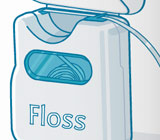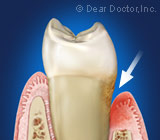Foolproof Flossing
 Dental professionals agree that effective removal of plaque, the film of bacteria (also called a biofilm) that gathers on everyone’s teeth, is the key to good dental health. Daily brushing and flossing are the usual recommendation for plaque removal. It is important to ask us about effective brushing and flossing. At your next appointment, ask us for a demonstration.
Dental professionals agree that effective removal of plaque, the film of bacteria (also called a biofilm) that gathers on everyone’s teeth, is the key to good dental health. Daily brushing and flossing are the usual recommendation for plaque removal. It is important to ask us about effective brushing and flossing. At your next appointment, ask us for a demonstration.
Effective brushing removes plaque from the easily accessed surfaces of the teeth. To remove plaque from between the teeth, you must floss.
Some people find it awkward to hold the floss with their fingers as they move it around their teeth. One technique for flossing, suggested by a dentist in Dear Doctor magazine, may make it easier than more traditional methods, although it does take a little practice.
Preparation
This method requires tearing off a 10 to 12 inch length of floss and tying it to form a circle big enough for your fingers, but not your thumbs, to fit within it. The circle should be knotted with a double knot.
To Clean Teeth and Gums
Keep the floss taut at all times, with about and inch or less between your thumb and index fingers for your upper teeth, or index fingers only for your lower teeth. Curve the floss around each tooth and gently move it up and down until you hear a squeaky clean sound. Extend the downward movement of the floss to just below the surface of the gum, without being too harsh and causing injury. As you move from tooth to tooth, move around the floss circle so that each tooth gets a clean section of floss.
Upper Teeth
Place all your fingers in the ring, with the floss over your left thumb and right index finger to floss your upper left teeth, and over your right thumb and left index finger to do the other side.
Lower Teeth
Use both index fingers to floss all your lower teeth.
You may only need to floss once a day before or after brushing to keep your gums health and ward off periodontal (gum) disease. Your dentist will guide you as to how often you may need to floss your teeth. Try this technique and see how it works for you.
Contact us today to discuss your questions about flossing techniques.
Advanced Periodontal Disease Requires an Aggressive Treatment Strategy
 Periodontics is a branch of dentistry that specializes in the supporting structures around the teeth, including the gums and bone, as well as the ligaments that join these structures to the tooth roots. From the Latin peri (“around”) and the Greek odont (“tooth”), periodontics serves one purpose: to keep these supporting structures healthy.
Periodontics is a branch of dentistry that specializes in the supporting structures around the teeth, including the gums and bone, as well as the ligaments that join these structures to the tooth roots. From the Latin peri (“around”) and the Greek odont (“tooth”), periodontics serves one purpose: to keep these supporting structures healthy.
This specialty is critical when it comes to periodontal disease. The term actually refers to a category of inflammatory diseases that affect the periodontal tissues. The inflammation arises from the body’s response to bacterial plaque that has collected at the gum line because of poor oral hygiene. It begins as gingivitis (inflammation of the gums), but if left untreated can develop into periodontitis, which results in bone loss. If left to continue, eventual tooth loss occurs.
Proper oral hygiene and regular cleanings are your best defense against developing periodontal disease in the first place. Once the disease gains a foothold in the area below the gum line, routine brushing and flossing will not be enough. To defeat the disease will require more aggressive treatment.
This usually begins in our office with oral hygiene instruction, scaling and root planing or debridement to rid the root surfaces of plaque and calcified deposits, also referred to as tartar or calculus. This may be followed up with a surgical procedure to remove any remaining pockets that were too deep to resolve with conservative treatment.
Another option we may add to your oral hygiene routine is the use of an anti-microbial mouthrinse, usually containing a 0.12% solution of chlorhexidine. We may also prescribe the use of a topically-applied antibiotic such as tetracycline to stop the infection and promote tissue healing.
Once the disease is arrested, it’s important that you continue good oral hygiene practices. Vigilance and prevention are critical to keeping these all important structures around your teeth healthy and functioning.
If you would like more information on the diagnosis and treatment of periodontal disease, please contact us for a consultation.
Your Dentist May Have the Solution to Your Snoring and Sleep Apnea
 Your snoring isn’t just an annoyance to other members of your household — it could indicate a serious health issue. Fortunately, there are treatments, some of which your dentist might be able to provide.
Your snoring isn’t just an annoyance to other members of your household — it could indicate a serious health issue. Fortunately, there are treatments, some of which your dentist might be able to provide.
Snoring is the result of soft tissue structures in the back of the throat, including the tonsils, the uvula, the tongue or fat deposits, collapsing on each either and obstructing the flow of air into your lungs. The obstructions produce a vibration that is the source of the snoring.
These obstructions could lead to a serious condition known as Obstructive Sleep Apnea (OSA). As the name implies, the obstruction causes a complete cessation of airflow for several seconds. As oxygen levels drop, the body responds by waking for one to three seconds (known as “micro-arousals”) to restore airflow. These disruptions can occur several times a night, as much as fifty times an hour. The depletion of oxygen and resulting low quality of sleep can contribute to high blood pressure, a higher risk of heart attack or stroke, and the possibility of accidents caused by lower alertness during the day.
You can help reduce the effect of OSA by losing weight and exercising. You may also be a candidate for Continuous Positive Airway Pressure (CPAP) therapy, which utilizes a device that delivers pressurized air into the airway while you sleep.
Depending on the exact cause and extent of your OSA, you might also benefit from treatments provided by your dentist. We can develop a custom-fitted oral appliance, similar to an orthodontic retainer or sports mouthguard, which you wear while you sleep. These devices work by repositioning the lower jaw forward, thereby maintaining an open airway by also moving the soft tissue of the tongue forward. For more advanced conditions, certain surgical procedures that realign the jaw or remove excess tissue, the tonsils and adenoids, or parts of the uvula or soft palate could be considered.
To know your best treatment course, you should schedule a complete oral examination to determine the exact cause of the obstruction, and possibly a polysomnogram, an overnight study performed in a sleep lab. And as your dentist, we might be able to provide the key for a better night’s sleep and a healthier tomorrow.
If you would like more information on how we can address your problems with sleep apnea, please contact us for a consultation.




